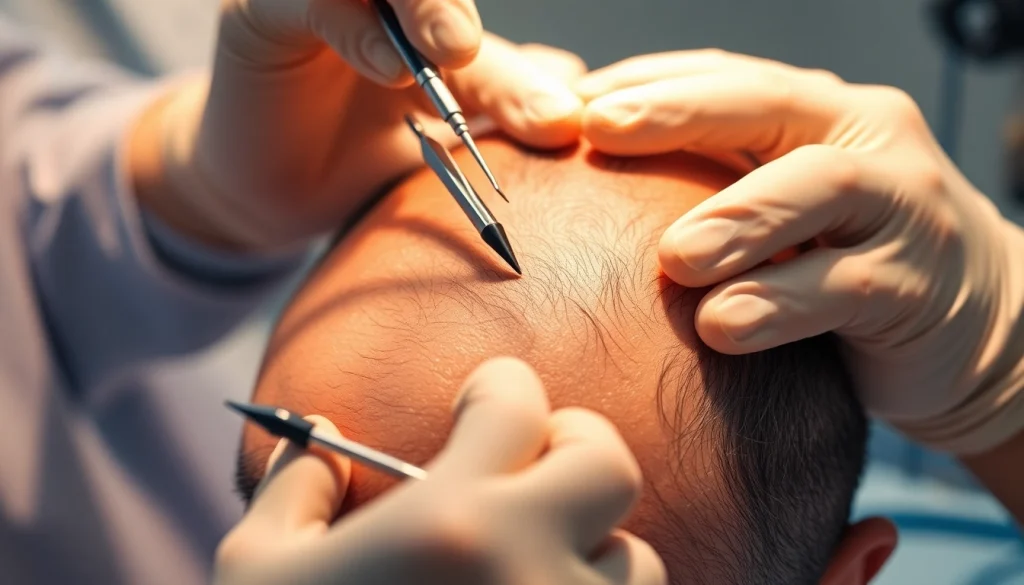
What is a Hair Transplant?
Definition and Overview of Hair Transplant
A hair transplant is a surgical procedure designed to restore hair to areas of the scalp that have become bald or thin due to hair loss. This procedure involves the removal of hair follicles from a “donor site”, which is typically an area of the scalp where hair is plentiful, and transferring these follicles to the thinning or bald areas. The procedure is regarded as a permanent solution to hair loss, providing natural-looking results that can significantly enhance one’s appearance. It is essential for patients to choose a reputable clinic for their hair transplant, as the skill of the surgeon plays a crucial role in determining the success of the transplant.
How Hair Transplants Work: The Procedure Explained
The hair transplant process can be broadly divided into a few steps. Initially, the patient meets with a specialist to determine suitable candidacy for the procedure, discussing their hair loss patterns, expectations, and medical history. After the consultation, a detailed plan is created for the transplant procedure.
During the surgery, local anesthesia is usually administered to minimize discomfort. There are primarily two methods of harvesting hair follicles: Follicular Unit Transplantation (FUT) and Follicular Unit Extraction (FUE).
- Follicular Unit Transplantation (FUT): This technique involves taking a strip of scalp from the donor area and dissecting it into individual follicular units under a microscope. The area is then stitched up, and the harvested units are transplanted into the thinning area.
- Follicular Unit Extraction (FUE): In contrast, this method involves individually extracting follicular units directly from the donor area using a specialized tool, leaving minimal scarring and allowing quicker recovery.
After the extraction phase is complete, the surgeon meticulously places the grafts into the recipient area, taking care to follow the natural growth pattern of hair to ensure optimal results.
Types of Hair Transplant Techniques
Different techniques offer varying results and suitability for different patients. Some of the most common methods include:
- FUT (Strip Method): This traditional method provides a higher yield of grafts in one session and is often effective for larger areas of hair loss.
- FUE: This minimally invasive method is favored for its quicker recovery times and lack of linear scarring, making it ideal for those who prefer short hairstyles.
- SMP (Scalp Micro Pigmentation): Although not a hair transplant per se, this technique involves tattooing tiny dots on the scalp to create the illusion of thicker hair.
Benefits of Hair Transplant Surgery
Long-Lasting Results of Hair Transplant
One of the most significant advantages of hair transplant surgery is the longevity of its results. Once hair follicles successfully establish themselves in the thinning areas, they will continue to grow hair naturally, making it a permanent solution for hair loss. Studies have shown that transplanted hair can last for years without any substantial loss.
Aesthetic Improvements from Hair Restoration
Hair plays a vital role in a person’s appearance and self-image. Restoring a fuller head of hair can drastically improve aesthetic appeal. Patients often report feeling more youthful and revitalized after the procedure. Additionally, the modern techniques employed today can yield results that look incredibly natural, with an appearance that closely resembles naturally growing hair.
Mental and Emotional Benefits of Hair Transplants
The psychological effects of hair loss can be profound, affecting self-esteem and confidence. Many patients experience a significant boost in confidence and mood post-surgery. Improved self-image can lead to enhanced social interactions, professional opportunities, and overall quality of life. Research indicates that individuals who undergo hair transplant surgery often report a marked decrease in feelings of depression and anxiety related to their hair loss.
Hair Transplant Cost: What to Expect
Average Costs of Hair Transplant Procedures
The cost of hair transplant procedures can vary significantly based on the location, the surgeon’s experience, and the specific techniques used. On average, individuals can expect to pay anywhere from $4,000 to $15,000 for a hair transplant. FUE tends to be more expensive than FUT due to the labor-intensive nature of graft extraction, with costs typically ranging between $6,000 and $10,000 for FUE compared to $4,000 to $8,000 for FUT.
Factors Influencing Hair Transplant Pricing
Several factors can influence the total cost of a hair transplant, including:
- Geographic Location: Costs often vary by region, with urban centers typically charging more.
- Surgeon’s Expertise: Highly experienced surgeons may command higher fees for their services.
- Number of Grafts: The larger the area needing coverage, the more grafts will be required, impacting cost.
- Technology and Techniques: Clinics using advanced technology and techniques often charge more due to the higher quality of service.
Insurance and Financing Options for Hair Transplants
Since hair transplants are generally classified as elective cosmetic procedures, most insurance plans do not cover them. However, some clinics offer financing options to help patients manage the cost. Payment plans and medical financing can make the procedure more accessible for individuals concerned about the financial implications of surgery.
Recovery Process After Hair Transplant
What to Expect Immediately After Surgery
After the procedure, patients will typically experience some swelling, redness, and mild discomfort in the treated areas. These symptoms generally subside within a few days. A follow-up appointment is usually scheduled within the first week to monitor healing and ensure the transplanted hair follicles are establishing themselves as expected.
It’s crucial to follow post-operative care instructions carefully, which may include avoiding strenuous activities, sun exposure, and certain hair care products for a specific period.
Long-Term Care and Maintenance Tips
Long-term care following a hair transplant is essential for maintaining the health of the newly transplanted hair. Patients are often advised to:
- Use gentle shampoos and avoid harsh chemical treatments.
- Avoid pulling or tugging at the transplanted area.
- Follow a healthy diet rich in vitamins and minerals that promote hair growth.
- Stay hydrated and manage stress effectively.
Common Recovery Challenges in Hair Transplants
While many patients have a smooth recovery process, some may experience challenges such as:
- Shock Loss: Some individuals may temporarily lose existing hair around the transplanted area as the scalp adjusts to the new environment.
- Infection: Although rare, infections can occur. Patients must recognize signs of infection and seek medical attention promptly.
- Inconsistent Hair Growth: Some patients may notice varying growth rates amongst transplanted follicles, which can impact overall aesthetic results.
Potential Risks and Considerations of Hair Transplant
Understanding Hair Transplant Risks
As with any surgical procedure, hair transplants come with inherent risks. Potential complications could include:
- Scarring at both the donor and recipient sites.
- Infection or bleeding during or after the procedure.
- Unfavorable aesthetic results, including unnatural hairlines or graft placement.
Understanding these risks is crucial for patients deciding whether to pursue a hair transplant.
Dealing with Complications Post-Procedure
If complications do arise, addressing them swiftly is essential. Follow-up consultations are vital for monitoring recovery and assessing any issues. Surgeons may prescribe medications or recommend additional treatments to manage pain, prevent infection, and improve overall outcomes.
Is Hair Transplant Right for You?
Deciding whether a hair transplant is the right solution requires careful consideration of individual circumstances, including the extent of hair loss, medical history, and personal goals. Consulting with a qualified hair restoration specialist can help assess the feasibility and appropriateness of the procedure based on individual needs.






